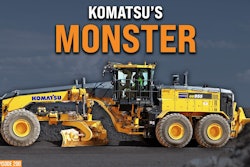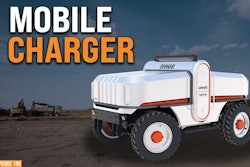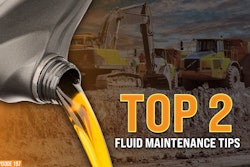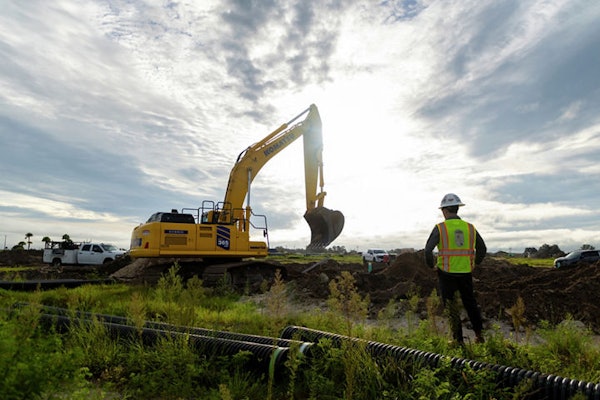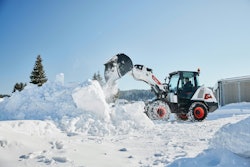Think that new engine oil right out of the jug is clean?
Think again.
To achieve equipment manufacturers’ specifications for oil cleanliness, Chevron offers the ISOCLEAN program that pre-filters lubricants for customers.
As out guests on The Dirt explain, the cleaner oil will help your equipment reach its maximum life and save you money on maintenance and prevent downtime. That also means your machines can keep making money for you longer.
Gene Jensen, lubricants trainer, and Chad Bertrand, manager of the ISOCLEAN Certified Lubricants Program, run through a rapid series of question from host Bryan Furnace detailing why new oil is not as clean as you think and why pre-filtered oil can deliver four times more life for your equipment’s components.
The 10-year-old ISOCLEAN program tackles the No. 1 enemy to your equipment’s lubricants: dirt. But it’s the dirt the eye can’t see that kills equipment. That’s where ISOCLEAN steps in to remove those microscopic particles and render lubricants as clean as OEMs specify to reach their machines’ maximum life.
So to learn more about the ISOCLEAN program in an entertaining Q&A format, check out the latest episode of The Dirt.
Equipment World serves up weekly videos on the latest in construction equipment, work trucks and pickup trucks – everything contractors need to get their work done. Subscribe and visit us at equipmentworld.com!
In This Episode:
- 00:00 – New Oil Actually Isn’t That Clean
- 00:32 – Chevron ISOCLEAN Overview
- 02:29 – 10 Questions About Oil Cleanliness
- 02:50 – I’m a Contractor, Cleanliness Doesn’t Matter
- 03:32 – If Oil Looks Clean, Why is it Dirty?
- 04:28 – How Easy is it to Contaminate Oil?
- 05:13 – Why is Oil Dirty if it’s New?
- 06:30 – Is an Oil Filter Not Enough?
- 07:38 – Benefits of Oil Filtration
- 10:19 – Old Equipment
- 10:58 – Storing Clean Oil
- 13:27 – What if I Already Pre-filter Myself?
- 14:44 – Who Is ISOCLEAN For?
- 16:26 – Final Thoughts
00:00:00:09 - 00:00:20:20
Bryan Furnace
Today we're here to talk about your oil cleanliness. But we're not talking about the oil cleanliness in the engine. We're talking about the cleanliness of the oil straight out of the jug. And it turns out it's not as clean as you think.
00:00:20:22 - 00:00:32:03
Bryan Furnace
Here to help us today is Gene and Chad, who are going to tell us about the ISO clean program.
00:00:32:05 - 00:00:41:08
Bryan Furnace
So, Chad, I'll start with you. Can you give us at a high level just an overview of what the Chevron ISO clean program is and how it benefits customers.
00:00:41:10 - 00:01:01:15
Chad Bertrand
Yeah, absolutely. So again, thanks for for having us, Brian. So this is a program that Chevron's had in existence for roughly about ten years. And what it is is we have the ability to to filter oil and deliver it to customers pre filtered. So I know a lot of your customers may try to filter on their own to get some cleaner oil going into their equipment.
00:01:01:17 - 00:01:25:09
Chad Bertrand
What Chevron is able to do is through a network of distributors that we have that are certified to deliver ISO clean products. They do the filtration, they deliver it clean and filtered to the customer with a certificate showing, Chevron certifies that this oil has been filtered to this cleanliness level that you've asked for, that the OEM recommends and and brings it, to the customer.
00:01:25:11 - 00:01:43:10
Chad Bertrand
You know, for as far as what the benefits are, it's really it's the bottom line. It's helping keep their equipment running longer, which is ultimately going to have a positive impact on the financial part of their company. They're going to be able to keep their doors open. So that's really the big pieces. Longer life on the equipment increase reliability.
00:01:43:10 - 00:01:52:01
Chad Bertrand
That's the benefit to the customer. And again, when you start doing all the math and it comes down to dollars and cents and the profitability of the customer.
00:01:52:06 - 00:02:09:04
Gene Jensen
So on the add a little bit to that, Brian. What it is, is it's filtering brand new. All the oil that you get, I don't care whose oil it is when you get it in, it's not that clean. It just isn't. So we filter brand new oil before we bring it to the customer so that they can start clean.
00:02:09:06 - 00:02:28:22
Gene Jensen
That's what I say a clean house, but there is a whole bunch in front of that. Yes, it has to happen before you bring clean oil, because if you've got dirty five-gallon pails or if you've got dirty buckets or your tanks all bad. Okay, none of this other stuff even works here. There's a bunch of stuff we have to do on the front end first.
00:02:29:00 - 00:02:47:06
Bryan Furnace
So here's the deal, gentlemen. I knew that you were going to come in, and you were going to tell me that oil out of the jug isn't clean enough. So I have prepared questions for you guys that I'm just going to rapid fire throw at you as a contractor who is skeptical that oil out of the jug is not clean.
00:02:47:08 - 00:02:55:07
Bryan Furnace
All right, Genene, here you go. My first question. I operate in a dirty environment already. I'm a dirt contractor, so cleanliness doesn't matter.
00:02:55:09 - 00:03:13:19
Gene Jensen
Go. That is untrue, Brian. You you know, people come to me. I work in a dirty environment. They think they're the dirtiest. You know, they work in the dirtiest place. And nobody else on God's green earth works on it. Under dirt is everywhere. Dirt is the number one enemy. We have to keep dirt out. And you know what?
00:03:13:19 - 00:03:30:23
Gene Jensen
It's the dirt you can't see. You cannot look at oil and tell if it's clean because it's the little particles that are around ten microns that get in there, and it's that size particle and you can't even see around ten minutes. We can only see the 40 microns. So Brian, that is incorrect.
00:03:31:01 - 00:03:40:17
Bryan Furnace
Okay Chad, your turn. And Gene kind of stole your thunder, but I want you to follow up on it. I can't see any dirt in my oil. So how are you telling me it's dirty? It's got to be clean.
00:03:40:18 - 00:04:01:09
Chad Bertrand
Yeah. If you can see stuff in your all, you do have major problems, but. But it's not clear. The stuff we're talking about today is. Gene said it's not visible. So as he said, it's about ten microns. You hold it up. Hey, it looks clean. No, it's not stuff. What we're talking about is microscopic 4 or 6, 14 size or micron sized particles.
00:04:01:11 - 00:04:18:13
Chad Bertrand
And so it's that small stuff that's doing the most damage because the clearances that are in the equipment stuff gets wedged in there. It's going to cause wear. And so it's stuff you just cannot see. And so you can't focus on, hey, if it's if I can see it or if I can't see it, it must be clean.
00:04:18:15 - 00:04:27:18
Chad Bertrand
Now the stuff we're talking about again, microscopic. So it's still doing a lot of damage and stuff you can't see is doing the most damage that equipment.
00:04:27:20 - 00:04:40:23
Bryan Furnace
Okay, Gene. Next question. I take my funnels. I've got my blue shop towels. I wipe them out. How much dirt or particulate matter does it take to contaminate my oil? I've already wiped it out with the blue shop towel.
00:04:41:01 - 00:05:02:12
Gene Jensen
Not very much. So I'm a grandpa. Feed these these grandkids. And you know those little rubber spoons. They don't hold very much dirt. You put that much dirt and the 55-gallon drum. You're killing the hydraulic system twice as fast. It doesn't take much care at all. But what happens, Brian, you leave that funnel out of that five-gallon bucket out, okay?
00:05:02:12 - 00:05:12:15
Gene Jensen
You wipe it out with a rag. All you did is kind of smear stuff around, okay? You're introducing way more than than you even take. And it doesn't take much.
00:05:12:17 - 00:05:23:04
Bryan Furnace
Chad. Next question. I'm buying this brand new from the factory. It's clean oil. How in the world can it be dirty? What's the condition? I'm being sold right now.
00:05:23:06 - 00:05:40:14
Chad Bertrand
Well, we refer to it as typical. So what you're getting is typical oil. So whether you're getting a from Chevron or another, another supplier, it's all coming out of the factory or the refinery about the same, but the blend plant all about the same level. And it's not being tested for cleanliness. It's just not part of the practice.
00:05:40:14 - 00:06:01:02
Chad Bertrand
And so when you think about the chain of custody that oil goes through, by the time it gets to your customers. So from the plant to put maybe on a rail car or truck to take them to a distributor, distributor pumps it off into their bulk tank. And then they put it on a delivery truck and time it gets there, it can be touched 7 or 8 times.
00:06:01:04 - 00:06:21:20
Chad Bertrand
And so every time it's touched opening the window for airborne particles and or water vapor, whatever it may be, to get into that oil. And so what you're getting initially is, is typical oil. And it's typical because it's not being clean and it's wet regardless. Again, if you're buying it from it's all going to be about the same cleanliness level.
00:06:22:02 - 00:06:29:01
Chad Bertrand
And it's not good enough for the OEMs that, has set its cleanliness standards on the lubricant.
00:06:29:03 - 00:06:41:04
Bryan Furnace
Okay, well, here's the deal. I have an ace up my sleeve, Chad Gene, my equipment has an oil filter on it, sir. So you're telling me I have to clean my oil when I already have a oil cleaner on it?
00:06:41:06 - 00:07:00:18
Gene Jensen
Yeah, that's exactly what I'm telling you. And the reason is, is because those oil filters. Okay, they get the big part. Let's be honest. You know the stuff. You can see most of those oil filters, they do a really, really good job. But the particles that are four and six microns in size, they just keep right on going through that filter medium.
00:07:00:20 - 00:07:28:20
Gene Jensen
And they're the ones that do the real damage. Now of course if you've got big particles in there, they do catastrophic damage. What we're talking about is long term wear, little bitty pieces of sandpaper that you can't see in there. And there's there's literally thousands. We do a test where we take a milliliter, and the brand-new oil of those little, teeny particles might have 50,000 particles in a milliliter, which is only a few drops of oil.
00:07:28:22 - 00:07:36:20
Gene Jensen
And so there's all these little pieces of sandpaper you can't see in there doing the damage. So your filter gets the big stuff. It has a hard time with the little stuff.
00:07:36:22 - 00:07:56:19
Bryan Furnace
Fair enough. Chad, next question. What are truly the benefits of a cleaner oil? My equipment is running just fine right now with you. Well, I've got where am I going to see the benefits of pre filtering this oil. But before we get into that, I want to take a second to tell you about the sponsor of this video, Chevron Lubricants.
00:07:56:21 - 00:08:18:07
Shawn Frasier
These cranes work around the clock for months at a time. If one of these agents ever goes down, it cost more than our reputation. Switching to Delos 600 and ADF, it's been a game changer. We've had no issues with cloud NFS. I mean, no region likes, no cleaning, no replacements, nothing. This all goes beyond anything we've ever used.
00:08:18:09 - 00:08:21:16
Shawn Frasier
I choose proven protection that keeps our cranes on the job.
00:08:21:18 - 00:08:26:03
Gene Jensen
I choose Delos 600 ads.
00:08:26:05 - 00:08:29:21
Bryan Furnace
Where am I going to see the benefits of pre filtering this oil.
00:08:29:23 - 00:08:49:14
Chad Bertrand
So you're going to get longer life. And that's the whole piece of this is extending the life to the OEMs. What they say is a full life of that equipment. So right now you may think hey I'm getting four years out of this pump. I'm changing this pump every four years. I'm good. Well, the pump really should be going say maybe ten, 12 years.
00:08:49:19 - 00:09:04:16
Chad Bertrand
So you're only getting half, maybe a third of the life. And so that's what this clean oil can do. It's all about keeping your equipment up and running and getting the maximum life out of that equipment. So that's the true benefit of using clean oil.
00:09:04:18 - 00:09:30:06
Gene Jensen
Now I'm going to add a little bit to that Brian. The average is is if we can get oil to the cleanliness that caterpillar wants on the average that component lasts four times longer. Wow. We're talking transmission. We're talking final drives. We're talking hydraulics. Now the engines you don't get that much but you still get some. Yeah, you get 1.31.82 times those sort of things.
00:09:30:06 - 00:09:31:12
Gene Jensen
That's what we're talking about.
00:09:31:17 - 00:09:36:09
Bryan Furnace
All right. Now technically following the rules of this game, it should be Chad's turn because I.
00:09:36:09 - 00:09:37:16
Gene Jensen
Know I jumped in here.
00:09:37:17 - 00:09:55:02
Chad Bertrand
I'll jump back in on okay. Fair enough. Oh it's again. So it's I mentioned earlier it then it comes back to dollars and cents. You know if you keep that equipment running longer, if I don't have to buy a pump every four years, if I can buy a pump every 12 years. So there's cash. There's money that can be used for something else within your operation.
00:09:55:02 - 00:10:12:05
Chad Bertrand
And so that's what it comes down to, is keeping the equipment running longer. It's going to help your bottom line, your profitability, be able to use resources in other areas that you need instead of focusing on replacing a pump or replacing transmission, whatever it is. Much sooner than you should be.
00:10:12:07 - 00:10:27:03
Bryan Furnace
Fair enough. Chad, thank you for for setting the game back into the proper space that it needs to be. Yeah, we're back to balance. So Gene, next question. My equipment is old and warm out. Why would I benefit from this clean oil.
00:10:27:05 - 00:10:45:10
Gene Jensen
You know what. You're using that piece of equipment. So it must be making your money. So why not extend the life? You know, the stupid story I tell is, you know what? Grandma's old. She's in the nursing home. Let's just give her bad blood. You know, there's there's not going to. She's not going to last that much longer.
00:10:45:10 - 00:10:58:10
Gene Jensen
And that's the same mentality. Like, really? I mean, you're running that piece of equipment because it's making you money. Why not make it last as long as you can't? If the oil were cleaner, it would last longer even with all the equipment.
00:10:58:12 - 00:11:11:02
Bryan Furnace
So Chad, next question. And we kind of touched on this when we were initially talking about the ISO clean program. But why would I go through all this trouble to just put that oil into my bulk tanks that I've got in my shop that are probably dirty?
00:11:11:04 - 00:11:35:06
Chad Bertrand
Yeah, it's a great question and it's seems illogical to do that. And so we've done studies on this where we've taken all the oil output, clean ISO, clean oil in and after a series of delivery. So maybe a third, a third, a third or a third, whatever we eventually get when we test that oil in the bulk tank, we get to say it's 18, 16, 13 or whatever the specification you're looking for.
00:11:35:07 - 00:11:47:03
Chad Bertrand
We can get there. And so it's called passive tank cleaning. And so it's that concept of taking dirty out, put clean in. You keep doing that over a period of time. You're going to end up with clean oil in your tank.
00:11:47:05 - 00:11:51:02
Gene Jensen
Now break, break. Breaking the rules again. Breaking the rules.
00:11:51:02 - 00:11:52:01
Bryan Furnace
Again. There we go.
00:11:52:05 - 00:12:11:10
Gene Jensen
All right okay I want to add something to that. Is that that works if the tank is not breathing dirty air. Yes. And is not bringing in moisture a drum. Well, you look at a drum. Okay. At the top of it's got a chime around it, you know, a rim around it. And that's a three-quarter inch swimming pool.
00:12:11:10 - 00:12:35:21
Gene Jensen
The water gets rain. Okay. They say, well it's got to seal that seal keeps out driftwood and that's it doesn't keep out anything else. Those those threads they're not pipe threads okay. They'll breathe. And so then that water sitting there, it'll get warm. The vapors go out, it gets cold. The you know, it pulls the water in. And so we suggest you tilt that, put those bonds at 3:00 and 9:00 so that water runs off there.
00:12:35:21 - 00:12:47:08
Gene Jensen
Get rid of that dirty old nasty can get a sealed container, one that has a color on it. You know, engine oil is a color. Hydraulic oil is a color difference. You know, final drive is a color. Those.
00:12:47:11 - 00:12:52:16
Bryan Furnace
But I still get to use my universal my universal funnel right.
00:12:52:18 - 00:13:11:10
Gene Jensen
Now get rid of the universal final as well. You know, the best can drop cans that I like. They actually have a spout on it. So you don't need a funnel. So there's a lot of things that you have to do with the tank. If you do have bulk tank, you can't breathe shop air. You got to get that humidity in that dirt out of there.
00:13:11:10 - 00:13:26:04
Gene Jensen
So there's a lot of things that can be done at the front end. And then the ISO clean, which is the next level to the OEM cleanliness level, pre-filter that can come later, but without doing all that stuff at the beginning doesn't work at the end.
00:13:26:06 - 00:13:31:20
Bryan Furnace
Okay, so now I have because Gene keeps jumping in, I've lost track of who's supposed to answer. So this I'm.
00:13:31:20 - 00:13:32:10
Gene Jensen
Next.
00:13:32:11 - 00:13:46:05
Bryan Furnace
I'm next girl. It's my last eight ace up my sleeve that I've got for you is well guess what Gene? I already pre-filter my oil with my own little on-site filters. Why do I need I so clean?
00:13:46:07 - 00:14:06:13
Gene Jensen
Well, you might be doing it wrong, Brian. Here's the deal. Is that we have a recipe for every oil. Like if you're doing hydraulic oil, you need to have a different recipe. What do you mean by recipe? That means micron size. That means banner, which is efficiency. That means what temperature you filter that you don't temperature, you don't filter this stuff at room temperature.
00:14:06:16 - 00:14:25:05
Gene Jensen
And then how many times you filter it. So you actually might be harming the oil. Okay. If you say, you know what, I want to filter the heck out of this oil. I'm going to put a two-micron filter on there. Okay. That's all fine and good. But you may be pulling a lot of stuff. The anti-foam is one of the first thing that comes out.
00:14:25:06 - 00:14:41:12
Gene Jensen
But you may be harming the oil if you don't know what you're doing. And we've spent a bunch of time we don't filter every one of our oils. Yep. Not every one of our oils is in this program. Okay. We have to be able to test it so that we, you know, we don't harm it when we filter it.
00:14:41:12 - 00:14:43:02
Gene Jensen
And there's a recipe for that.
00:14:43:04 - 00:15:01:18
Bryan Furnace
Fair enough. Well, my final question for you, Chad. And this is a point I think we do need to clarify who really qualifies for the ISO clean program. Are we talking this is something I can do at the jug level. Or is this something where we're talking larger contractors that have a shop that are dealing in bull tank situations?
00:15:01:19 - 00:15:21:14
Chad Bertrand
Yeah. So the ISO clean program, we do it in bulk or 330-gallon totes. So we don't, package it right now in drums or pails. And there's a there's reason I think we've touched on it earlier. When you come to the packaging process, keeping those airborne particles out of the drums. And again, drums can breathe. There's nooks and crannies.
00:15:21:17 - 00:15:43:15
Chad Bertrand
Stuff can get in those drums. Same thing with a pail or a jug or whatever may be. You've got a lot of plastic stuff in there that from the blow molding when they create those. So it's really difficult to try to maintain that cleanliness level in those smaller packages. And so therefore we we keep it in bulk tanks or 330-gallon totes as well.
00:15:43:15 - 00:15:59:12
Chad Bertrand
And so you know what we have, we have a network of distributors, and they can come to your location. They can pump off. And if you've got a smaller, say a bulk tank or a few into your sump, whatever, we can do that. They are trained and know how to do that, to pump in directly into your equipment.
00:15:59:14 - 00:16:17:10
Chad Bertrand
So don't think that limits you to, oh, I can't do ISO clean because I don't have a big tank farm or you know, I'm typically get it in smaller packages, you know, work with our network of distributors we have of North America, and they can get the solution to you and figure out how they can deliver that ISO clean product to you.
00:16:17:12 - 00:16:24:16
Bryan Furnace
Well, Chad Gene, thank you guys for being on. I learned a lot today. Thank you for educating us on the ISO clean program. I appreciate it.
00:16:24:18 - 00:16:25:02
Gene Jensen
All right.
00:16:25:03 - 00:16:25:22
Chad Bertrand
Thank you.
00:16:26:00 - 00:16:44:00
Bryan Furnace
Well, thank you again for Chad and Gene coming on the show to share their knowledge on the cleanliness of already what we consider clean oil. As you can see, it's not nearly as clean as you think it is coming straight out of the factory. And there are some real benefits to further filtering that oil before it goes into your very, very expensive equipment.
00:16:44:02 - 00:16:48:00
Bryan Furnace
As always, I hope this helps you and your business. We'll catch you on the next episode of The Dirt.

